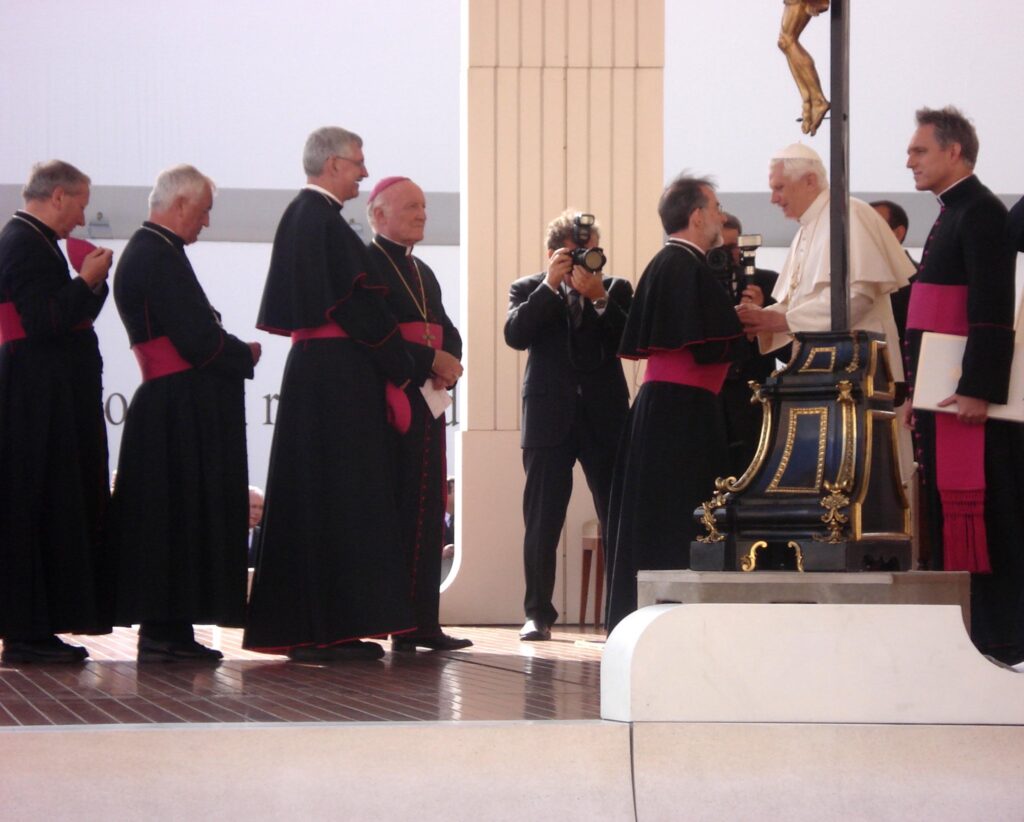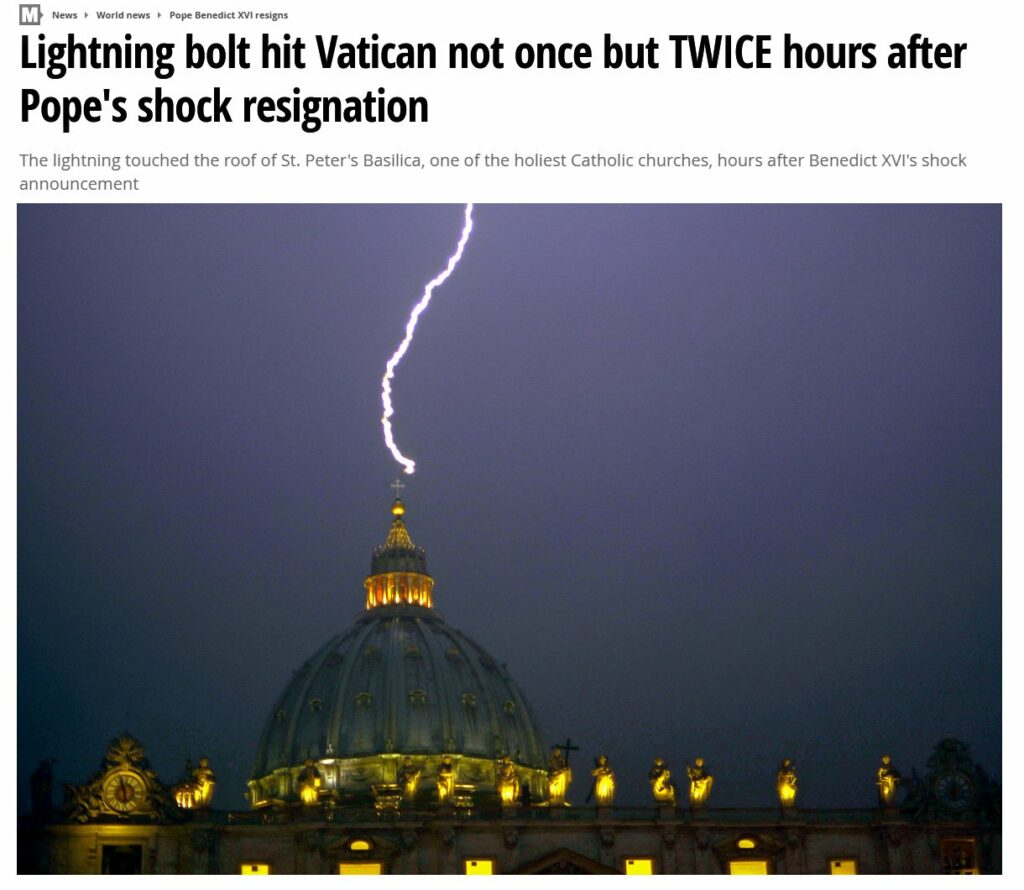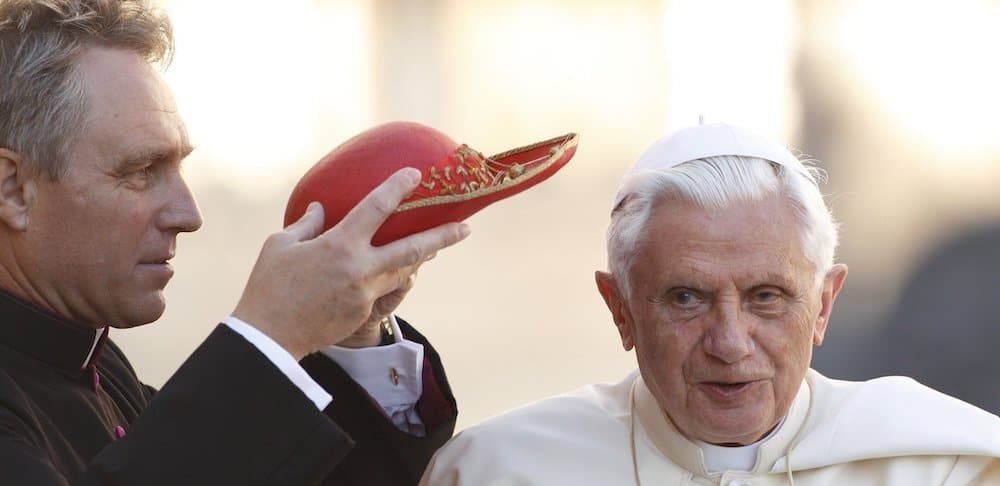p/c CNS, Paul Haring
Why can there be only one Pope at a time? Because Christ set up 12 Apostles but only one Pope. St. Peter is “mentioned 191 times (162 as Peter or Simon Peter, 23 as Simon and 6 as Cephas).” That is more than all the other Apostles combined. Thus, Peter’s office (munus in Latin) is singular. The Pope is much more than “first among equals” as the New Testament clearly proves in the above numbers. On top of this, numerous Magisterial documents (and saints that stood against anti-popes in history) all insist: There can only be one valid Pope of Rome at any one time.
Yet a decade ago, the Vatican’s Archbishop Georg Gänswein erroneously believed Pope Benedict XVI could bifurcate the papacy into “an expanded ministry.” Even the mainstream Aleteia ran a story back in 2016 that quoted Gänswein explaining this: “Since the election of his successor Francis, on March 13, 2013, there are not therefore two popes, but de facto an expanded ministry — with an active member and a contemplative member. This is why Benedict XVI has not given up either his name, or the white cassock. This is why the correct name by which to address him even today is ‘Your Holiness.’.. on February 11, 2013, speaking in Latin in front of the surprised cardinals, he introduced into the Catholic Church the new institution of ‘pope emeritus.'”
Notice again this was published in 2016—after the alleged-resignation of Pope Benedict XVI in 2013, but before his death in 2022. Clearly Gänswein did not believe Benedict fully resigned the papacy. Did Benedict? This might seem like an outdated question, but the answer to it may also reveal nothing short of how God Himself sees the current Church crisis in Rome, now at a fever pitch.
In 2023, I wrote an article about two relatively-unknown aspects of duress under which Pope Benedict XVI semi-resigned the Papacy in 2013. As you can see in that article, Canon 188 asserts: “A resignation made out of grave fear that is inflicted unjustly or out of malice, substantial error, or simony is invalid by the law itself.” The above linked article evaluates the “grave fear” placed upon Benedict from 2010 to 2013. In that sense, Benedict was the victim of the St. Gallen mafia in his quasi-resignation from the papacy.
But was Benedict also the perpetrator of an attempted bifurcated-papacy upon the whole Church? Some say yes, and that this was based on substantial error in regards to an understanding of the papacy that preceded his election by decades of his academic career. Proponents of this theory insist that substantial error could include a false-understanding of the papacy leading to a half-resignation, which would obviously be tantamount to no-resignation at all (at least until death.)
To be sure, some traditionalists today insist that Pope Benedict XVI meant to fully resign the papacy (and they insist they can prove it.) Others say he did not mean to fully resign. (They also say they can prove it.) The fact is: Both groups can prove it. But Benedict saw nearly everything through the Hegelian eyes of: Thesis + Counter-thesis = Synthesis. Basically, two opposite “truths” can be united to create a Super-Truth (or synthesis.) For most of the last decade of his life, Benedict did believe Francis was Pope. This is true. But Benedict also believed Benedict was Pope. This is seen in the overwhelming evidence to follow that Benedict erroneously believed a Pope could semi-resign. 1
In Pope Benedict XVI’s 2013 Declaratio (considered to be his resignation from the Chair of St. Peter, archived here) Benedict referred first to the papal munus (office) twice at the beginning of that short 250 word document, but later he only renounced the ministry of St. Peter (“plena libertate declaro me…renuntiare…ministerio Episcopi Romae, Successoris Sancti Petri”) translated on the Vatican website in English as: “With full freedom I declare that I renounce the ministry of Bishop of Rome, Successor of Saint Peter.” Again, at the beginning of the document he clearly refers to the office, but later renounces only the ministry (in that short 250 word document.)
I have studied languages intensely for 20 years. Anyone who says “munus means the same thing as ministerium” not only reveals they have no understanding how Latin works, but they also reveal they have no understanding how language works. The first step in learning a language is knowing that each single word reveals reality or a lie. Yes, there are synonyms, but even synonyms do not mean exactly the same thing. (Munus and ministerium are not even synonyms, by the way.) Yes, Pope Benedict XVI was a Hegelian who erroneously believed the truth is found between thesis and anti-thesis. However, he was still a German who used words with surgical precision.
Combining these two facts, the outcome is obvious: Benedict meant munus and ministerium as two different things. However, these two things (as will be proved later in this article) would become (in his broken Hegelian mind) a contemplative-Pope and an active-Pope. Of course, in true Catholic theology, neither of these things can exist side-by-side.

Dr. Edmund Mazza discovered that even before being elected Pope, Cardinal Ratzinger believed the papacy endured the following development: “I think we should be honest enough to admit the temptation of mammon in the history of the Church and to recognize to what extent it was a real power that worked to the distortion and corruption of both Church and theology, even to their inmost core. The separation of office as jurisdiction from office as rite was continued for reasons of prestige and financial benefits.”—Cardinal Ratzinger, Principles of Catholic Theology, 1987, emphasis mine.
Thus, when Pope Benedict XVI quasi-resigned in 2013, he believed he could bifurcate the papacy into a dual-papacy. Again, his Hegelian-mindset was a curse (not a blessing) upon the entire Catholic Church in all of this. Consider more proof of this in an interview three years later with Mr. Peter Seewald:
Peter Seewald: “Is a slowdown in the ability to perform, reason enough to climb down from the chair of Peter?”
Pope Benedict: “One can… make that accusation, but it would be a functional misunderstanding. The follower of Peter is not merely bound to a function; the office enters into your very being. In this regard, fulfilling a function is not the only criterion”
Notice that Pope Benedict XVI considered it merely an “accusation” that he fully resigned the papacy in that interview in 2016 (three years after his putative-resignation.) Yet Pope Benedict XVI knew very well that he left the active-papacy to another (as seen in the above word function) but kept the contemplative-papacy to himself (munus) as he said in that interview above: “The follower of Peter is not merely bound to a function; the office enters into your very being.”
Thus, Pope Benedict clearly believed that in 2005, the office of the Chair of Peter entered into his “very being” until his death in 2022. Nothing could whisk away that forever-gift of the papacy, he erroneously believed. How do we know this? See again the quote from Principles of Catholic Theology that he wrote in 1987 as Cardinal Ratzinger. In other words, he had a broken idea of the papacy even before becoming Pope.
But in traditional Catholic theology, a resigned-Pope is supposed to be no Pope at all. Jesus Christ Himself established that there can only be one Pope at any one time in Catholic Church history, as proved in the first paragraph of this article. Any attempt for a Pope to eschew part of the papal responsibility would therefore be null and void.
Sadly, Benedict did not believe traditional theology on the papacy here. This theological reality that stands against his legacy is clearly buttressed by the folly of Benedict’s own words during the week of his “resignation.” These words are still shockingly found on the Vatican website (archived here) for Pope Benedict XVI stated:
“The ‘always’ is also a forever’ – there can no longer be a return to the private sphere. My decision to resign the active exercise of the ministry does not revoke this. I do not return to private life, to a life of travel, meetings, receptions, conferences, and so on. I am not abandoning the cross, but remaining in a new way at the side of the crucified Lord. I no longer bear the power of office for the governance of the Church, but in the service of prayer I remain, so to speak, in the enclosure of Saint Peter. Saint Benedict, whose name I bear as Pope, will be a great example for me in this. He showed us the way for a life which, whether active or passive, is completely given over to the work of God.”
Notice that when Pope Benedict XVI said “Yes” to the papacy in 2005, he considered that step to be an “always” and a “forever” act that was irreversible (even if resigned.) Of course, I believe this is substantial error, for he believed this idea even past his unusual attempt at becoming the “contemplative Pope” in 2013. Hence, in the above quote, he remained both physically and hierarchically within the “enclosure of St. Peter.” (Some translations call it the “precincts of St. Peter.”)
There was clearly substantial error in Benedict’s understanding of the papacy in 2013 (and many years prior, as seen in his writings as Cardinal.) In fact, when Benedict was alive, I asked Fr. Paul Kramer on my podcast (at min 30) if the notion of the active-Pope working alongside the contemplative-Pope was exclusively the idea of Cardinal Georg Gänswein or if it was the idea of both Georg Gänswein and Pope Benedict XVI. Fr. Kramer strongly answered in favor of the latter. And he should know, for he has had many high-ranking contacts in Rome for decades. (More evidence of this is presented by an American civil attorney at Catholic Esquire.)

That night in 2013, lightning struck the Vatican twice. Does that sound like a resignation accepted by God? Even Benedict himself stated: “I no longer bear the power of office for the governance of the Church, but in the service of prayer I remain, so to speak, in the enclosure of Saint Peter.” Yet he kept his word in living as Pope in the Vatican. Few people doubt this. Thankfully, Mark at Non Veni Pacem frequently reminds us: Pope Benedict living in the Vatican from 2013 onwards kept wearing white as the Pope and gave the Apostolic Blessing (as only a Pope could do.) Benedict even invented the new, fake term: Pope Emeritus.
All of the above is overwhelming evidence that Benedict purposely attempted a semi-resignation from the Chair of Peter. Yet even the most basic papal theology over 2,000 years has held that a semi-resignation is no resignation at all. Pope Benedict XVI now knows (and probably always knew over the last decade) that he forfeit the papacy only at his death in 2022.
